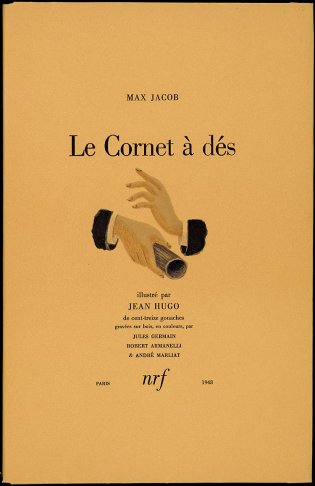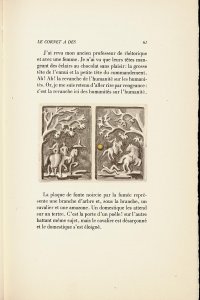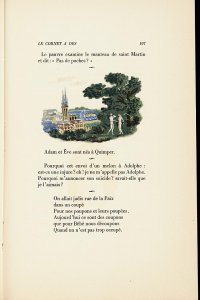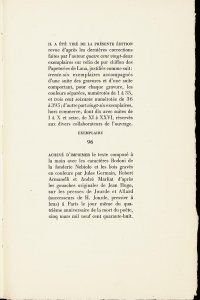Le cornet à dés
Year: 1948
Author: Max Jacob (1876 - 1944)
Artist: Jean Hugo (1894 - 1984)
Publisher: NRF
Miniatures
Book illustration was more than a side activity for Jean Hugo: it was his passion. He placed himself in an age-old tradition of book illustrators, most of whom toiled anonymously over their drudgery. His illustrations are therefore strongly reminiscent of old-fashioned miniatures: small, carefully produced, bright pictures that are placed between the texts. Most of his work as an illustrator was done on books by his friends, so that they could discuss the way the book would be produced together. In this fashion, he also created illustrations for works by Pierre-André Benoit, Cocteau, Radiguet and Maurois.
Jean Hugo also knew Max Jacob, if only professionally: they would run into each other at exhibitions. In 1947 Hugo produced two paintings that referred to Max Jacob: 'The House of Mme Persillard where Max Lived 15 VIII' and 'Rue Max-Jacob at St. Benoit, 1947'. In a number of ways, Jacob and Hugo could be considered each other's opposite: Hugo broke with religion, while Jacob converted; Jacob's art is systematic, while that of Hugo is personal. But in spite of their different ideas about art, this edition of Le cornet à dés is extremely harmonious.
Bibliographical description
Description: Le cornet à dés / Max Jacob ; ill. par Jean Hugo de 113 gouaches gravées sur bois, en couleurs, par Jules Germain, Robert Armanelli & André Marliat. - Paris : NRF, 1948. - 210 p. : ill. ; 27 cm
1st edition: 1916
Printer: Jourde en Allard (Paris)
Edition: 422 copies
This copy: Number 96 of 422 on Lana
Typeface: Bodoni
Bibliography: Bénézit 7-249/250 ; Monod-6298
Shelfmark: Koopm L 493
References
- Pierre Andreu, Vie et mort de Max Jacob. Paris, La Table Ronde, 1982
- *Jean Hugo: **Une rétrospective*. Arles, Actes Sud, 1995.
- *Max Jacob,**poète et romancier*. Pau, PUP, 1995
- Sydney Lévy, The play of the text: Max Jacob’s Le cornet à dés. Wisconsin, The University of Wisconsin Press, 1981

![Pagina [17] met voorwoord van Max Jacob en illustratie door Jean Hugo](/sites/default/files/styles/galerie/public/images/le-cornet-a-des-p17.jpg?h=26ca844d&itok=pf6XmGnS)



